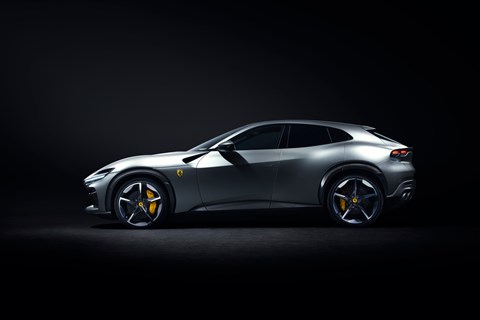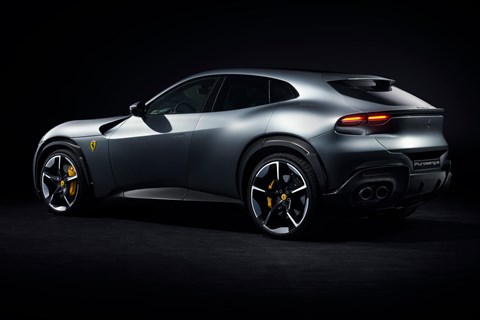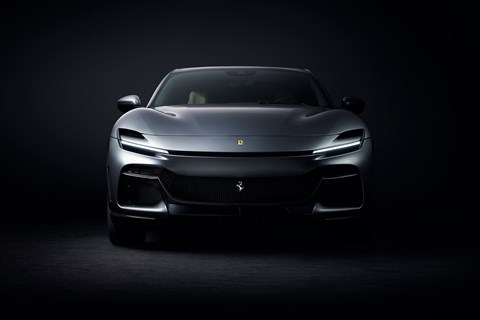► Ferrari’s Purosangue SUV officially revealed
► The full story on Maranello’s ‘four-door 2+2’
► V12, active suspension and a huge asking price
Ferrari’s Purosangue – quite possibly one of the automotive industry’s worst-kept secrets in recent history – has been officially revealed. The all-new model is the start of Ferrari entering the crossover SUV segment, even if Maranello is adamant about calling the Purosangue anything but.
How much will it cost?
The new SUV will cost £313,120 OTR with a four year warranty, as well as a seven year Ferrari genuine servicing included.
Tell me more about the Purosangue
‘Every single model we make should be a sports car,’ says Enrico Galliera, Ferrari’s chief marketing and communications officer. And even if Maranello has built a high-riding, four-door, four-seater – its teams of engineers and designers have strived not to compromise on anything.
Ferrari’s new Purosangue (pronounced san-gway, rather than sang) is described as a four-door 2+2 and, while it’s Ferrari’s first-ever four-door production car, it’s not its first four-door full stop. Ferrari and design house Pininfarina experimented with adding extra doors to the 400 back in the late 70s, developing a one-off concept called the Ferrari Pinin, which is said to be stored somewhere in the bowels of Maranello.
And, while they’ve been at it, Ferrari has taken subtle pot-shots at the competition and its SUVs, with Galliera saying that ‘while competitors understandably share parts to improve efficiency, we do not do that here.’ Take that, Urus, Cayenne and Bentayga.

It’s a big moment, then. Not just for Ferrari, but for all SUV-kind. Oh no, I said the forbidden word!
Very funny… talk us through the Ferrari Purosangue design first
To our eye, it still looks like a Ferrari, even if it’s not one we’ve ever really seen before. ‘We wanted to create something like an F1 car in evening dress,’ says Flavio Manzoni, Ferrari’s chief of design. ‘Our wish is to design the future, not redesign the past,’ he says when asked about a seeming lack of heritage-heavy design cues.
‘But we still wanted to create a berlinetta shape,’ he adds. Regardless, it’s pretty bang on from our own illustrations we created in the summer of 2022.
Ferrari’s Centro Stile has been working on shaping the Purosangue for five years. The grand building right in the heart of Ferrari territory in Maranello is said to have two major design teams – one that focuses more on sports cars, and another that directs their attention towards GTs. ‘Here, the GT team took the lead,’ says Manzoni.
Manzoni guides us through the design process, pointing to how there’s a technical lower half where the valances and wheelarches are, with a sleek and more classic-looking body silhouette above, that gives the impression it’s sitting on top. Aerodynamics here are key, with details like the headlights featuring integrated air vents that direct airflow over the bonnet and more vents in the rear valance to reduce pressure in the wheelarches.

And Ferrari did all of this without any form of customer clinics or feedback, it claims. Manzoni describes the design process as organic, with the eureka moment being ‘when external teams say it looks like a real Ferrari.’
Ferrari’s first production four-door, eh?
Indeed, which is quite a big deal. The Purosangue remains a 2+2, like all of the brand’s grand tourers including the GTC4 Lusso and FF in its most recent history, ‘because a five-seater would not be consistent with us,’ says Manzoni.
In order to stand out, though, Ferrari has made the rear doors rear-hinged. The brand calls them ‘Welcome doors,’ and they’re designed to increase space for those getting in and out of the rear seats. We’d call them suicide doors and they’re powered for your convenience; each of the four seats has a huge amount of adjustment, too.

In fact, the whole interior is a step up in terms of usability for Ferrari. We had some time investigating the interior, and it’s an interesting concept. The brand’s arguably frustrating haptic touch panel-controlled steering wheel remains, but there are new controls for the air-conditioning and seat controls via dials in the centre of the car, as well as the ability to include a passenger display that’s far larger than Ferrari’s ever installed before.
Interestingly, Ferrari says it’s taken the decision to not feature navigation in the Purosangue. Galliera cites cyber security reasons, saying that Ferrari doesn’t have the same resources as some larger OEMs or even major software giants to keep all of its client’s data safe in the event of a hack, so it’s reducing the amount of infotainment services it will offer to customers out of the box.
‘The level of security is not enough for us to satisfy our clients,’ he says. Instead, Ferrari says that wireless Apple CarPlay and Android Auto are standard, as is a wireless charger, so customers can use those services instead.

For you practicality-focused folk out there, the two rear seats fold down to improve the 473-litre boot space (which just so happens to be 23 litres more than you could get in a GTC4 Lusso). Oh, and you can’t have a tow bar – Ferrari’s team say it would have meant completely redesigning the rear end to be able to fit one.
Instead, Ferrari is setting up a series of aftermarket accessories to help you enjoy your leisure pursuits.
I need all the performance specs you can give me – NOW
Sit down – you might be here a while.
First of all, it’s been common knowledge for months before the Purosangue’s reveal that it features a V12. ‘When we communicated it would have a V12, interest absolutely exploded,’ says Galliera, adding that the platform the Purosangue is built on a platform that’s ‘optimised’ for the V12 engine. Reading into that, using the word ‘optimised’ doesn’t mean it’s the only powertrain that’ll ever be available for Ferrari’s SUV. But it’s the only one confirmed for now.
It’ll be a while before we see a fully-electric Ferrari, even if Maranello has confirmed one is coming, but would make some sort of sense as the Purosangue’s lifecycle matures that a more environmentally-friendly powertrain may be included at a later date.

The engine itself is all a bit familiar, if as delectable as a Ferrari 12-cylinder always is. It’s a 6.5-litre naturally-aspirated V12 developing 715bhp at 7750rpm (just 500rpm from the V12’s redline) and 528lb ft of torque at 6250rpm, allowing the Purosangue to sprint to 62mph in just 3.3 seconds, manage 0-124mph in 10.6 seconds and can power on up to more than 193mph.
Ferrari claims it’s all-new, given the different demands requiring more torque at a lower rpm than pretty much every other V12-powered Ferrari, for example. Even so, the V12 is still marked within the F140 family of engine codes – which happen to all be V12s that have dated back as far as the Ferrari Enzo.
But it’s the utterly enormous amount of technology on offer that really separates the Purosangue from any other luxury SUV on the market. The biggest feather in its cap is Ferrari’s new active suspension system developed with Multimatic. Galliera admits the Purosangue ‘would not have been possible’ without this technology.
The active suspension system features electric motor actuation, allowing the wheels and body’s forces to be more accurately controlled, and allows for higher suspension frequencies than adaptive damping. The active suspension is designed to eliminate body roll when even a sniff of it is sensed by the car’s accelerometers and sensors, while also being able to react far quicker to bumps in the road. It’s also here to help manage the Purosangue’s weight; the SUV is 2033kg dry, or 2180kg with fluids and driver – lighter than a DBX, Urus and Bentayga.
This plus all-wheel drive (power is sent through an eight-speed dual-clutch transmission to all four wheels) means the Purosangue has at least some semblance of off-road ability. But Bentley with its Bentayga or Lambo’s Urus, which both have off-road modes, the Purosangue does not beyond hill descent control. ‘But you have to know, it’s not a Jeep,’ says Gianmaria Fulgenzi – Ferrari’s chief product development officer, pointing out that’s it’s useful for snow and dirt trails but not rock-crawling or wading.

As well as the active suspension tech, the latest version of Ferrari’s Side Slip Control suite of traction control systems. Remember when it was just designed to help Ferrari’s slide without crashing? Now we’re on version 8.0, with the Purosangue introducing ‘ABS evo’ that works with the Purosangue’s brake-by-wire system, as well as four-wheel steering, an e-diff and more.
So how will it be to drive? ‘Think of it as being closer to an 812 than a Roma,’ says Fulgenzi. We’ll have to wait until 2023 before we likely get behind the wheel.
How much is it? When can I get one?
Naturally, Ferrari’s closest and friendliest clientele got the heads-up first. Galliera points out that a car like the Purosangue has been repeatedly asked for by Ferrari’s best and most loyal customers, as they complain they have to buy other large luxury cars instead to fill their more practical needs. So, as you’d understand, the first batch of production cars have already been allocated.
Ferrari ‘doesn’t want to be all about one car,’ adds Galliera, saying that Maranello will cap its Purosangue production to ‘no more than 20 per cent of Ferrari’s sales – it’s a way to protect our positioning as a brand.’ Once again, it seems Maranello is mocking Sant’Agata, in that regard – especially given how much the Urus makes up Lambo’s sales numbers each year these days.

As for an actual figure, Galleria says the Italian price would be €390,000 including local taxes. We’ll have to wait to get a nailed-on price in the UK, but expect a starting price of at least £300,000 before any options get added. The first left-hand drive European cars will arrive in the second quarter of 2023, with UK right-hand drive models expected in the late summer of the same year.
Read all our Ferrari reviews here